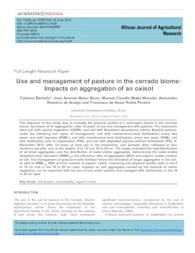Use and management of pasture in the cerrado biome: Impacts on aggregation of an oxisol.
Use and management of pasture in the cerrado biome: Impacts on aggregation of an oxisol.
Author(s): BERTOLIN, F.; BONO, J. A. M.; MACEDO, M. C. M.; ARAUJO, A. R. de; PEREIRA, F. de A. R.
Summary: The objective of this study was to evaluate the physical quality of a dystrophic Oxisol in the Cerrado biome, by means of its aggregation, after 19 years of use and management with pasture. The treatments were soil with natural vegetation (CERR); and soil with Brachiaria decumbens cultivar Basilisk pasture, under the following four types of management: soil with maintenance-level fertilization, every two years, and with legumes (PAML); soil with maintenance-level fertilization, every two years (PAM); soil with fertilization only at implantation (PAI); and soil with degraded pasture without fertilization (PD). In November 2012, after 19 years of land use in the treatments, soil samples were collected at four locations per plot, and at two depths, 0 to 10 and 10 to 20 cm. The study evaluated the size distribution of air-dried aggregates and the distribution of water-stable aggregates, determining the water-stable weighted mean diameters (WMDws), the efficiency ratio of aggregates (ERA) and organic matter content of soil. The management of grassland with fertilizer favors the formation of larger aggregates in the soil, as well as WMDsw, ERA and the content of organic matter, improving soil physical quality, both in the 0 to 10 cm and in the 10 to 20 cm layer. Impacts on soil aggregates caused by the removal of native vegetation can be improved with the use of soil under pasture and managed with fertilization in the 10 to 20 cm layer.
Publication year: 2016
Types of publication: Journal article
Unit: Embrapa Beef Cattle
Observation
Some of Embrapa's publications are published as ePub files. To read them, use or download one of the following free software options to your computer or mobile device. Android: Google Play Books; IOS: iBooks; Windows and Linux: Calibre.
Access other publications
Access the Agricultural Research Database (BDPA) to consult Embrapa's full library collection and records.
Visit Embrapa Bookstore to purchase books and other publications sold by Embrapa.

